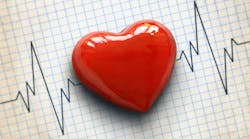American Heart Association’s adult cardiopulmonary resuscitation (CPR) courses will be updated in 2019 with the use of new technology.
The organization will implement an instrumented directive feedback device in all courses that teach adult CPR skills, effective Jan. 31, 2019 to assist participants with becoming proficient when a cardiac emergency occurs.
“The American Heart Association trains more than 22 million people in CPR annually through its course offerings, said Mary Elizabeth Mancini, Ph.D., MSN, American Heart Association volunteer and professor, senior associate dean for education innovation at The University of Texas at Arlington College of Nursing and Health Information in a statement. “Requiring a feedback device further solidifies its global leadership position in resuscitation science and CPR education training,”
According to the AHA, the devices provide, real-time, audiovisual and corrective evaluation and instruction on chest compression rate, depth, chest recoil and proper hand placement during CPR training. The organization made the change based on a 2015 study on the benefits of emerging technology such as feedback devices.
This technology, which can be implemented into or serve as an accessory to a manikin, helps students master these critical CPR skills and reduces the time between training and demonstration of competence in a training environment.
This new requirement impacts the Association’s Basic Life Support (BLS), Advanced Cardiovascular Life Support (ACLS), ACLS for Experienced Providers and Heartsaver adult CPR training courses taught in the United States and internationally. Future goals will be to implement the technology into all courses such as infant and child, not just adult skills classes, Mancini said.
“CPR saves lives and ensuring our courses provide the necessary, correctly performed skills gives healthcare providers and others trained in CPR confidence and empowers them to help in doubling survival rates from cardiac arrest by 2020,” she said.
Each year, more than 350,000 cardiac arrests occur outside the hospital and over 200,000 occur in a hospital setting. Only 46 percent of people who suffer an out-of-hospital cardiac arrest receive bystander CPR before professional help arrives. CPR, if performed immediately and correctly, can double or triple a victim’s chance of survival, according to the AHA.
